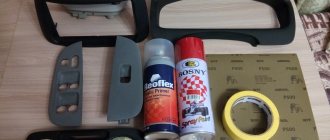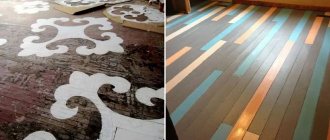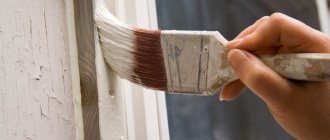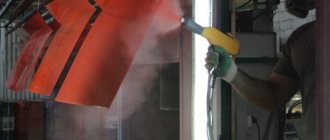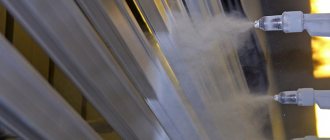What kind of plastic can be painted?
There is no point in painting some of its types. Even after careful preparation of the surface, the coating will quickly come off. It is impossible to determine the type of plastic by external signs. To find out on what basis it is made, you should study the markings:
- ABS plastic: styrene copolymer based on impact-resistant resins; opaque, soluble in esters, acetone, dichloroethane; easily tolerates low (up to -40°C) and high (+90°C) temperatures; used in the production of housings for household appliances, furniture, electric lighting devices, large auto parts, batteries; when painting, use special plastic paint for cars or regular acrylic enamel; requires preliminary priming;
- PVC: colorless transparent material based on vinyl chloride; resistant to acids and alkalis, due to reduced frost resistance (can withstand temperatures not lower than -15°C) is used only for products used indoors, wires and cables, pipes, suspended ceilings, linoleum, window profiles, furniture; Before painting with special enamels for plastic, it must be primed;
- polystyrene (PS): thermoplastic, can be used at temperatures down to -40°C; chemical resistance is low; used for the manufacture of formwork, sandwich panels, cladding, ceiling tiles; cable supports; painting is not possible;
- polycarbonate (PC): transparent impact-resistant material, with prolonged exposure to UV rays it becomes cloudy and becomes brittle; frost-resistant, melting point 150-300°C; used in the production of headlights, lenses, glasses, cellular polycarbonate used for the manufacture of canopies, greenhouses, road fences; it is impossible to paint this plastic;
- polyethylene (PE): good dielectric, high chemical resistance; can soften when heated; used in the production of packaging (film, bottles); sewer pipes, electrical insulation; equipment parts, denser low-density polyethylene in the improvement of children's playgrounds; its foamed modification in the production of thermal insulation; it is impossible to paint such plastic;
- polypropylene (PP): chemically resistant, soluble only in benzene and toluene; melts at a temperature of 175°C, not resistant to ultraviolet rays; used in the production of packaging materials, pipes, equipment parts, road surfaces; painting is not possible.
Thus, only ABS or PVC plastic can be painted. The coating will peel off quickly from soft surfaces.
Types of paints for plastics
Special requirements are imposed on compositions for coloring plastics. They should adhere well to the surface and have increased elasticity.
The industry produces special solutions designed specifically for coating polymer products. Acrylic enamel also has good adhesion. It can even be used to coat some soft plastics.
You can also use compositions intended for covering the skin. It is allowed to process plastic with oil paints. However, they hold up worse.
It is better to paint plastic using aerosols. When sprayed, the paint adheres better, without streaks. Using a spray can you can cover even hard-to-reach surfaces.
Is it necessary to apply a primer?
For this material, acrylic-based enamel primer is used. For better adhesion, after drying they can be treated with fine sandpaper.
Some types of interior plastic used in cars may not be primed. Such materials are not flammable. Therefore, it is easy to check whether they require a primer. It is enough to set fire to a small piece of plastic. If it starts to smoke, it means a primer needs to be applied.
Before painting plastic car parts, you can also dip them in water to check. If they sink to the bottom, there is no need to prime them.
Determining the need to prime the plastic
Before painting, plastic parts often need to be treated with a primer. Often, but not always. It all depends on what type of plastic this element is made of. It won’t be difficult to determine this at home; all you need is matches or a lighter. With their help, we need to set fire to a small area of the product.
If the combustion process is accompanied by soot, then priming is not necessary. Another life hack - the part needs to be immersed in a container of water, and if it floats up, then no primer is needed.
Materials and tools
To work with plastic you will need:
- white spirit, alcohol or other solvent;
- primer;
- putty for filling irregularities;
- fine-grain sandpaper: after processing the primer and the plastic itself with it, the paint sticks better;
- aerosol can, for covering large objects with a spray gun, roller or brush;
- rags or wipes for wiping;
- masking tape to cover the surface that is not being treated;
- sealant.
If you plan to use plastic in outdoor conditions, choose a special heat- and water-resistant paint for plastic. Such compositions should also not be afraid of ultraviolet rays.
To obtain an even, smooth surface, it is better to apply them using an aerosol. To coat large plastic objects, it is more convenient to use spray guns or rollers. When using brushes, choose products with the softest bristles that do not leave streaks.
Scope of application of aerosol coatings
Aerosol paints can be used in the following cases:
- restoring objects that have lost their appearance;
- for decorating spaces and premises;
- if necessary, giving additional strength to products (moisture resistance, abrasion protection).
Easy-to-use aerosols will allow you to work quickly even with a minimum of professional skills.
Surface preparation
Even if you know what paint to paint plastic with, that's not all. It must be properly prepared.
First of all, the plastic is dismantled and then disassembled into its component parts. Steel screwdrivers are not acceptable. Only special blades made of polyurethane. All parts are laid out on a soft surface - sheets of cardboard, chipboard. You should not use fabrics for these purposes - even the smallest lint can ruin the whole thing.
To avoid confusion during reassembly, the bolts and nuts are placed in separate boxes and labeled. When disassembling complex units, you can take photos of the initial state and individual stages.
Then the plastic must be degreased with white spirit, anti-silicone, gasoline or another type of solvent. Small irregularities and chips are repaired using putty. It is better to first smooth out large cracks and cracks with sandpaper and then fill them with sealant. To avoid scoring, use fine sandpaper first, and then coarse-grain sandpaper.
To improve adhesion, the plastic is matted - rubbed with fine sandpaper up to No. 180. To avoid dust, it is better to do this in water. After removing dust and drying, the surface is degreased again.
The last stage is coating with a primer. Without it, the paint will quickly crumble. The primer is applied in as thin layers as possible three times, drying well each time. To avoid drips, use aerosols or a spray gun.
Characteristics of dyes for plastic surfaces
Thanks to their convenient use, sprays are quite popular among designers and decorators.
Today the following types of cylinders are available for sale:
- Polymer. The combination of the characteristics of a primer and a dye allows polymer paints to have high adhesiveness and not require additional priming.
- Resistant to damage. Acrylates and polyurethane additives added to the aerosol composition make the paints especially durable. They are usually used on surfaces subject to constant mechanical stress.
- Structural. When drying, the enamels become slightly rough, which allows you to hide unevenness and cracks in the plastic. They are used in decoration to create an original design.
- Soft touch. The velvety layer obtained after painting looks great on interior items. Things decorated with enamel will create a feeling of softness and comfort.
- Monadic. They are used to paint PVC plastic. Resistant to UV rays and adheres well to surfaces.
A wide range of aerosol enamels allows you to choose your own individual paint for each type of plastic.
Painting step by step
Let us describe in detail the process of painting with acrylic paint for plastic:
- Places that cannot be painted, especially when using aerosol cans, are best sealed with paper tape.
- The paint is applied in a very thin layer twice or thrice, each subsequent layer only after the previous one has dried.
- When using aerosols, shake them first.
- We'll tell you how to properly paint plastic from a spray can. It must be kept at a distance of 2-3 cm from the surface. Aerosol kits often include attachments to make the application process easier. To get a high-quality result, it is better to first practice on a small fragment.
- When using a brush, you need to put a little paint on the tip of the brush and carefully, pressing firmly to the surface at one angle, draw a stripe. As a result, the thinnest possible layer should be formed.
- Painting plastic car parts is not much different from regular painting. To achieve an aesthetic appearance, it is better to use a spray can or spray gun for these purposes.
- The last stage is polishing. It is produced by wax paste.
- To secure the paint layer, it is advisable to coat the plastic with acrylic varnish.
Features of working with plastic
In everyday life, the term “plastic” means products made from the following materials:
- polypropylene;
- plastics;
- polystyrene;
- polycarbonate.
But not all plastics are suitable for painting, since it is often much easier to initially select the material of the desired color. Such materials include polystyrene, polycarbonate and polyethylene - they are not painted.
Before you start painting the plastic, you need to remove all dirt from the surface and wipe it dry. When painting, the following nuances should be taken into account:
- The surface to be treated must first be thoroughly cleaned of dirt, grease, oil, bitumen and other stains. To do this, you can use a solvent.
- The plastic is also treated with an antistatic liquid to relieve stress generated by friction. This is necessary so that when painting, lint, hair and dust do not attach to the product.
- If an old product is to be painted, then to correct defects, the surface is initially puttied with a special putty for plastic, which is more elastic.
- Protrusions and irregularities formed on the putty must be sanded with sandpaper with moisture-resistant properties. Such an abrasive is necessary, because grouting occurs using water to smooth out all cracks and crevices.
Soft sandpaper for finishing Source livemaster.ru
- After drying, the product is degreased again.
- Three thin layers of primer are applied to degreased plastic for improved adhesion. The primer can be any: any color, two-component or multi-component.
- After the primer has dried, the surface is treated with sandpaper with an abrasiveness of 400-500.
- If you are going to paint the plastic yourself, you need to add a plasticizer to it and apply 2-3 layers using a spray gun. Before applying a new layer, you need to wait for the previous one to dry.
- Half an hour after applying the last layer, the surface is covered with varnish or metallic paint.
- To bring the product's appearance to perfection, a wax polishing paste is applied to it, which covers minor imperfections.
See also: Catalog of companies that specialize in finishing materials.
Expert advice
There are certain subtleties in working with this material:
- paint and plastic adhere better to each other if they have the same temperature, ideally 20-23°C; required air humidity 65-80%;
- You can paint a plastic surface with your own hands using oil paint; in this case, you should not skip the priming process;
- coating thickness should be 60-120 microns; if it is too thin, it will quickly peel off; if it is too thick, it will look sloppy;
- Painted plastic should be protected from dust during drying, otherwise the surface will become rough;
- dry it for at least 2-3 days; but it will finally gain strength only after a week;
- for quick drying of the surface, a temperature of at least +17°C is required;
- car parts covered with small scratches do not need to be painted, but can be updated using an abrasive polish; For processing large surfaces, it is more convenient to use a drill with an attachment.
So, we have described in detail what and how to paint the plastic in the car interior. To do this, it is not necessary to contact specialists. It is enough to stock up on acrylic enamel and carefully prepare the surface.
Automotive paints and their features
To paint plastic material yourself, car paints and primers are also suitable. The following suitable options can be distinguished:
- A base for varnish is used after priming the plastic; after drying the paint layer, varnish is applied in cans. It is possible to choose different effects - metallic, mother-of-pearl and others;
- With a chrome effect, the surface will be similar to chrome; chrome aerosols help quickly and effectively transform the surface;
- With the aluminum effect, the reverse side of aluminum foil is obtained, looking aesthetically pleasing.
There are also car paints with a variety of effects:
- Vinyl imitates leather, and the effect is not only external, but also the surface will feel like leather to the touch. The level of adhesion is high, so it can be used without priming;
- Heat-resistant, selected when working with electric kettles, coffee machines, etc. objects that may be exposed to high temperatures.
Vinyl imitates leather, and the effect is not only external, but also the surface will feel like leather to the touch.
